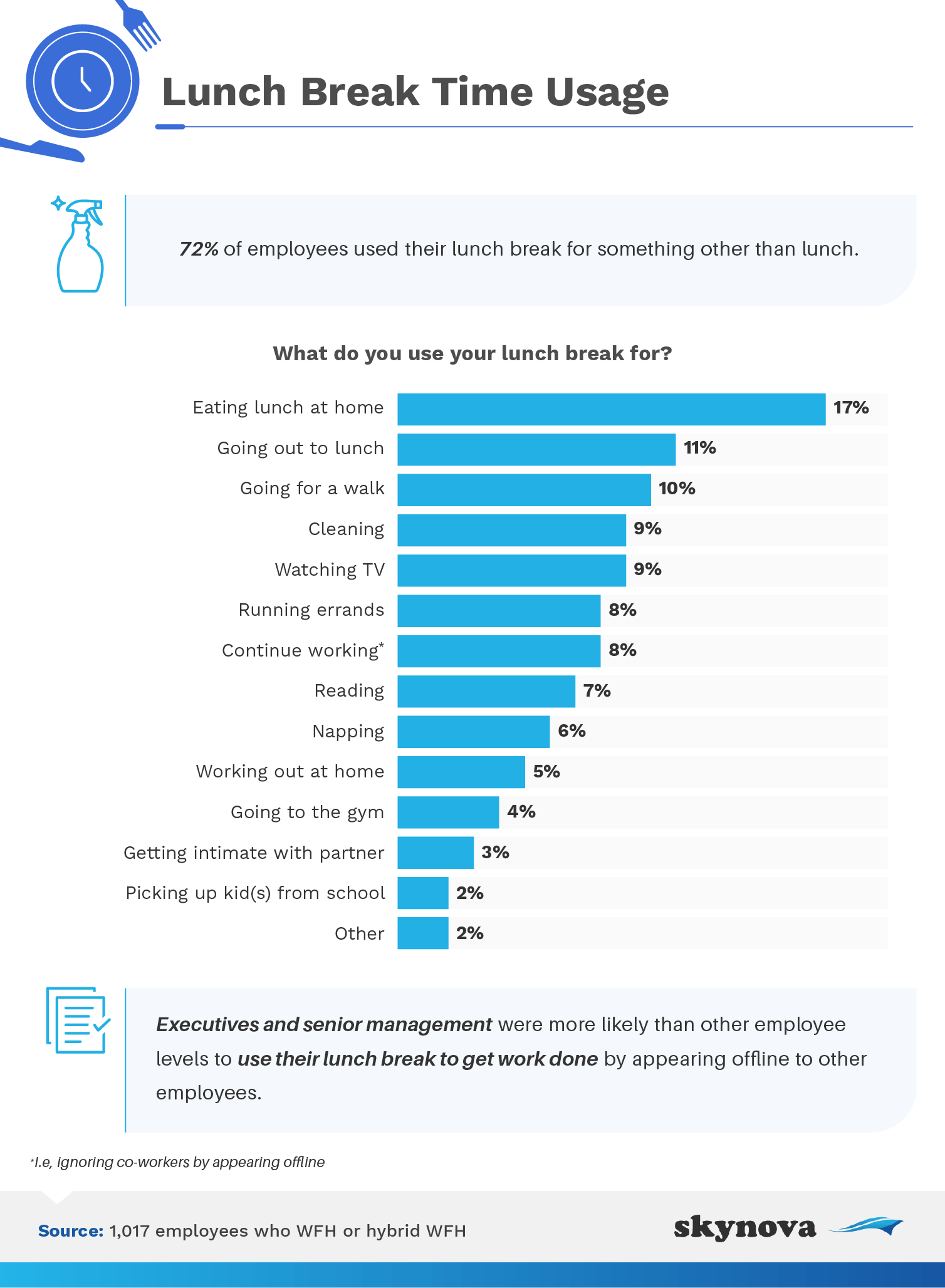
|
We surveyed over 1,000 people who work from home on either a full- or part-time basis. The data we collected provides an insight into the effects that working remotely has had on employees, including the way they obtain food, their weight, and their willingness to relinquish a lunch break entirely.
When working in the office, employees are influenced by the schedule of their peers. For example, your co-worker may ask you to take a walk and grab a cup of coffee. Similarly, when lunchtime rolls around, there may be a mass exodus to the break room. As the beeping of the microwave and the smell of reheated leftovers fill the air, you are reminded that it’s now time to take your own lunch break. However, this same unconscious reminder is not present when working from home. Of those remote workers who do opt for a snack break during the workday, more than 50% eat their lunch during meetings and conference calls. Further, nearly 13% admitted to forgoing their lunch break entirely when working from home.

What would cause someone to skip their daily PB&J sandwich? Some point to rising productivity expectations in the workplace as the main culprit – meaning the higher up in the corporate ladder employees are, the less likely they are to take a true lunch break. Entry-level employees most frequently take these breaks, with 90% reporting that they make the time to step away. Moving up the ladder, senior executives reported taking a lunch break 88% of the time. Nevertheless, when working from home, 84% of respondents said they are somewhat or very comfortable with breaking for lunch.
Changing where people work has also changed the way they eat during the day. The most obvious benefit of enjoying lunch at home is the ability to save money. When choosing a home-prepped lunch as opposed to dining out, employees can expect to save a whopping $1,200, on average, per year. Almost half of those surveyed (49%) reported doing their own meal prep when working remotely, while leaving home to dine out was the least popular choice.

Another emerging component of the new trend for remote working is the staggering increase of food delivery services. These services more than doubled their business during the pandemic and continue to be on the rise. According to our respondents, the top delivery methods were Uber Eats and DoorDash, representing 22% and 19% of orders, respectively. Meal kit deliveries from places like HelloFresh, Blue Apron, and Home Chef, rounded out the list at 10%. However, employees should be cautious about the financial implications of consistently utilizing these delivery services. Accounting for delivery charges and fees, ordering from apps like Uber Eats costs over 4.5 times more than eating leftovers. Similarly, expenses add up quickly when spending almost $15 per meal using a service like Delivery.com as opposed to approximately $4 on homemade leftovers.
The increase in remote working has also provided a level of work-life balance that employees have never enjoyed before. The convenience of working from home has opened the door for workers to utilize their designated breaks for more than just reheating last night’s lasagna. Taking a break in any capacity can improve overall productivity. While most employees – a combined 28% – found the most value in enjoying lunch either at home or out at a restaurant, others engaged in alternative activities.

Employees may leave the house completely, with 10% taking a casual stroll outside and 4% hitting the gym. Others preferred to catch up on their to-do list, as 9% reported cleaning and 8% running errands. Overall, the flexibility of remote working provides ample opportunity for employees to engage in a wider variety of activities during the day.
An unfortunate side effect of the COVID-19 pandemic across the country is weight gain. Many factors contributed to Americans’ increasing weight over the last 18 months, including stress and an inability to access fitness centers.

Likewise, the freedom to snack more frequently throughout the day while working remotely was a major offender. Approximately 35% of those surveyed reported gaining weight while working from home.
Working remotely has provided employees all over the country with the freedom to dictate how they want to spend their lunch break. Americans are free to step away from their desks at home to perform domestic chores or break a sweat at the gym. The financial savings are also evident for those opting to prepare their own meals at home as opposed to dining out daily. Moreover, the sudden push for remote work has thrust food delivery services, like Uber Eats and Doordash, further into the spotlight. Finally, a correlation exists between the level of an employee’s status within the company and the likelihood of making time for a lunch break. Overall, the push to work remotely has undeniably altered the way Americans do lunch and will continue to shape how they spend this time.
Skynova provides online software including invoices, accounting, time sheets, and more for small businesses across the country. Further, we strive to provide detailed articles about diverse topics that our customers are excited to read. These writings primarily focus on an aspect of the workplace and typically overlap with another area of society, including business and technology, politics, sports, health, and finance. The articles are based on surveys, statistics, and research conducted by our team.
We surveyed 1,017 respondents; 513 worked a hybrid of remote and on-site hours, and 504 worked fully remotely. 143 respondents were entry-level employees, 360 were midlevel, 145 were first-level management, 251 were mid level management, 112 were senior or executive level, and six reported their job level as “other.” 91 respondents were baby boomers or older, 242 were Gen Xers, 626 were millennials, and 58 were Gen Zers.
Survey data have certain limitations related to self-reporting. These limitations include, but aren’t limited to, telescoping, exaggeration, and selective memory. We didn’t weight our data or statistically test our hypotheses. This was a purely exploratory project that examines the effect of working from home on employee lunch habits.
Information related to lunch habits while working remotely is relevant to both employees and employers alike. If either of these descriptions apply to you, we hope you find this data helpful and potentially take away some personal insights. Further, we welcome you to share the article for noncommercial purposes and only ask that you link back to this page when doing so.